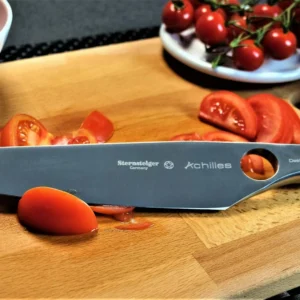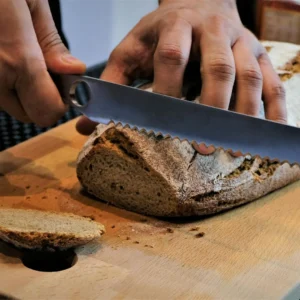Chef’s Knife Grip: A Beginner’s Guide
A proper chef’s knife grip is essential in every kitchen, ensuring safe, precise chopping of vegetables and slicing of meat. However, for many novices, the simple act of holding the knife correctly can be a challenge. A proper grip not only improves the efficiency of cutting but also significantly reduces the risk of injury. While kitchen knives are essential tools in every kitchen, using proper techniques can greatly reduce the risk of accidents and ensure a safer cooking experience. A large number of kitchen accidents can be avoided with proper knife handling. As such, learning to hold a chef’s knife correctly is key to both safety and efficiency.
Why Grip Matters
A chef’s knife, while versatile and powerful, can become dangerous if not handled correctly. Many beginners instinctively use grips like the hammer grip or point grip when they first pick up a knife. These grips, though common, aren’t always suited for the precision and control required when using a chef’s knife. The hammer grip, for example, works well with a cleaver when cutting through thick meats, but it lacks the finesse needed for slicing delicate ingredients.
Proper grip not only enhances the control you have over the knife but also makes the cutting process smoother and more comfortable. By improving your grip, you can minimise fatigue and strain on your hand, wrist, and arm, especially during extended cooking sessions.
The Pinch Grip: The Foundation of a Proper Knife Hold
 The key to a safe and effective grip is the pinch grip, a technique favoured by professional chefs. Unlike other grips that focus only on the handle, the pinch grip uses both your dominant hand and the blade. Consequently, this creates a secure hold and gives you much greater control.
The key to a safe and effective grip is the pinch grip, a technique favoured by professional chefs. Unlike other grips that focus only on the handle, the pinch grip uses both your dominant hand and the blade. Consequently, this creates a secure hold and gives you much greater control.
Locating the Balance Point
To begin using the pinch grip, it’s important to first locate the balance point of the knife. This is usually where the blade meets the handle. The balance point is where the knife feels most stable and allows for the smoothest motion while cutting. Finding this spot can be done by laying the blade flat on your index and middle fingers and gently moving your hand along the blade until it feels balanced.
Correct Hand Placement
First, find the balance point and place your thumb and index finger on either side of the blade. Then, grip it firmly without placing your fingers too close to the sharp edge. Your thumb should rest on one side of the blade, while your index finger should pinch the opposite side. This positioning allows you to guide the knife with precision while keeping your fingers well away from the sharp edge, reducing the risk of cuts.
Your remaining fingers should wrap comfortably around the handle of the knife, providing additional stability and control. Your wrist should remain aligned with the handle, with your hand positioned naturally for a fluid, controlled cutting motion.
Practicing the Pinch Grip: Getting Comfortable
When first trying the pinch grip, it may feel a little unfamiliar, but with some practice, it will become second nature. A great way to get used to the grip is by practising with simple tasks like chopping onions or slicing vegetables. These activities help you build muscle memory, making it easier to transition to more intricate tasks like slicing meat or dicing herbs.
To get accustomed to the feel of the knife in your hand, try using the rocking motion that many chefs employ. Place the knife on the cutting board and rock it gently back and forth, letting the sharp edge glide through the ingredients. This rocking motion is not only efficient but also offers increased control, particularly when working with larger quantities of food.
Improving Knife Skills and Efficiency: Chef’s Knife Grip
As your confidence grows, you’ll find that the pinch grip enhances your overall knife skills. It allows for greater control when chopping, slicing, or mincing, making the process much quicker and more efficient. The pinch grip adds stability and reduces hand fatigue during cutting tasks. As a result, it helps when preparing large meals or tough ingredients.
Additionally, using the pinch grip helps you develop better knife techniques. Grip the knife securely to make more precise cuts. As a result, your ingredients stay consistent for even cooking.
Transitioning to Advanced Techniques
 Once you’re comfortable with the pinch grip and the rocking motion, you can move on to more advanced techniques. For example, the claw grip can be used with the non-dominant hand to further enhance safety and precision. In the claw grip, your fingers are curled inward, protecting them from the blade while guiding the food in place. This grip works particularly well when dicing, as it ensures your fingers are out of the way of the knife while still offering support.
Once you’re comfortable with the pinch grip and the rocking motion, you can move on to more advanced techniques. For example, the claw grip can be used with the non-dominant hand to further enhance safety and precision. In the claw grip, your fingers are curled inward, protecting them from the blade while guiding the food in place. This grip works particularly well when dicing, as it ensures your fingers are out of the way of the knife while still offering support.
As your proficiency increases, you’ll be able to tackle more complex tasks, such as filleting fish or deboning meat, with greater ease. The pinch grip builds a strong foundation for advanced skills. Moreover, it provides control and stability for various techniques.
Common Mistakes to Avoid
While the pinch grip is a straightforward technique, beginners may still make some common mistakes that hinder their progress. One of the most frequent issues is gripping the knife too tightly. Although it’s important to maintain a firm hold on the knife, an overly tight grip can lead to unnecessary strain and fatigue. Instead, focus on finding a balance between a firm yet relaxed grip to allow for fluid movements.
Another mistake is holding the knife too close to the blade’s edge. It’s important to maintain a safe distance from the sharp part of the knife to reduce the risk of cutting yourself. Keep your thumb and index finger near the balance point, away from the edge, to maintain control without putting yourself in harm’s way.
Benefits of Mastering the Pinch Grip: Chef’s Knife Grip
Mastering the pinch grip offers several key benefits, particularly for those who are serious about improving their culinary skills. First, it enables greater control over the knife, allowing for more precise cuts. Second, it reduces hand fatigue, making it easier to prepare meals over long periods. Third, it enhances your overall safety in the kitchen, reducing the likelihood of accidents caused by improper knife handling.
Moreover, the pinch grip encourages better posture and wrist alignment, helping to prevent long-term strain on the joints and tendons. By adopting this technique early on, you can cultivate proper habits that will serve you well as you progress to more complex kitchen tasks.
Conclusion: Start With the Basics for Culinary Success
In conclusion, learning how to properly hold a chef’s knife is one of the most important skills a beginner can develop in the kitchen. The pinch grip provides a solid foundation for safe, efficient, and precise cutting. It may feel awkward at first, but with regular practice, the grip becomes second nature. As a result, you’ll prepare meals with greater ease and confidence. So, grab your chef’s knife, find that balance point, and get ready to master one of the most crucial kitchen skills. Happy cooking!